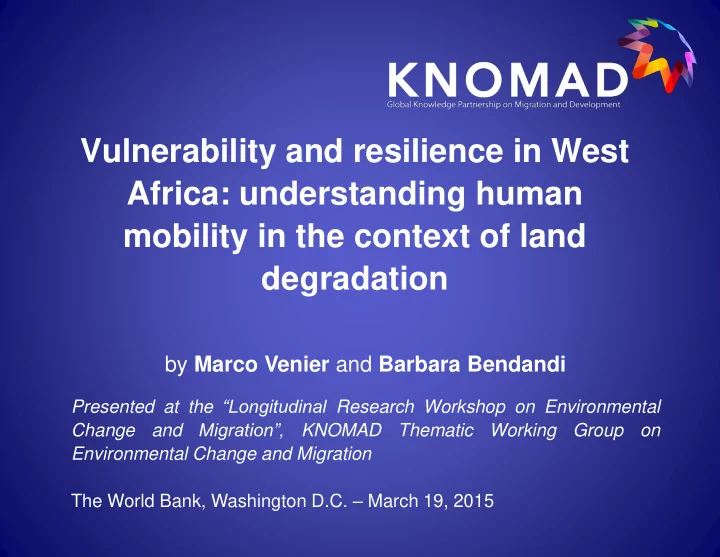

Vulnerability and resilience in West Africa: understanding human mobility in the context of land degradation by Marco Venier and Barbara Bendandi Presented at the “Longitudinal Research Workshop on Environmental Migration”, Change and KNOMAD Thematic Working Group on Environmental Change and Migration The World Bank, Washington D.C. – March 19, 2015
Structure of the Presentation I) West Africa, Slow Onset Events and Vulnerability Drought and reduced water availability Sea-level rise and coastal erosion II) Resilience, Land-based Adaptation and Migration Onsite Adaptation Intercontinental, Regional and Internal Migration Seasonal Migration vs. Relocation III) Unsafe Migration and Failed Adaptation
A Note on the Authors Marco Venier Barbara Bendandi
Climate Change and Slow-Onset Events Slow onset events: “ Insert short definition”
Slow Onset Events in West Africa – Increasingly common throughout the region – They affect the livelihoods of a growing number of populations through: Accentuating desertification and land degradation
Insert nice picture of desertification + Talk about expansion of Sahara desert (semi-arid zones, drylands, etc. All in IPCC).
Slow Onset Events in West Africa – Increasingly common throughout the region – They affect the livelihoods of a growing number of populations through: Accentuating desertification and land degradation Changing rainfall patterns and reducing freshwater availability
Map of rainfall patterns or picture of crops ruined by extreme / unplanned rainfall and talk briefly Picture of Lake Chad Shrinking
Slow Onset Events in West Africa – Increasingly common throughout the region – They affect the livelihoods of a growing number of populations through: Accentuating desertification and land degradation Changing rainfall patterns and reducing freshwater availability Causing sea-level rise and groundwater salinization
Picture of eroded coastal line + talk about sea water intrusion into coastal freshwater systems (look for a before / after picture of St-Louis area in Senegal)
Vulnerability Exposure: – Definition: Vulnerability is influenced by the level of exposure to slow onset climate stressors - Slow onset events impact upon terrestrial and oceanic systems on which primary sector activities – agriculture, cattle breeding, and fishing – rely - Rural populations are the most exposed; their vulnerability is the greatest
Vulnerability The population of West Africa is mostly rural – Percentage of rural vs. urban – GDP of agricultural and livestock activities Unprecedented expansion of coastal cities
Picture of peanut cultivation in Senegal (main product) Picture of Lagos slums
Resilience Can be broadly defined as a “remedy” to vulnerability Consequently entails measures that reduce exposure Can include: – Onsite adaptation – Temporary migration – Permanent relocation
Onsite Adaptation Conditions – Non-irreversible consequences Incentives – Knowledge and education – Economic enabling factors
Picture of SWC techniques application, NGOs..
Onsite Adaptation Thresholds A variety of factors determine thresholds beyond which populations deem onsite adaptation to be unfeasible – In Burkina Faso, the third consecutive year of drought has been found to be the one triggering out-migration – In other cases, these thresholds are imposed by the irreversible consequences of slow onset events This is the case in Linguère, Senegal, where sea-level rise has eroded arable land, imposing relocation to affected populations These thresholds are highly context-specific
If available, picture waves on agri fields..
Resilient Migration (International) Intercontinental and Regional Migration – Only afforded to those possessing the necessary financial capital to initiate migration The bulk of environmental migration is thus internal , as most environmental migrants lack these financial assets – Yet, through the key role of remittances , international migration impacts upon decisions to migrate in places of origin In Senegal, remittances finance the cheap wages of agricultural migrants from neighboring countries
Resilient Migration (Internal) Internal Migration – Captures most environmental migration – Not accounted for by governments and international bodies It can be – Temporary / seasonal – Permanent
Seasonal Migration Generally involves only one or few family members, not the entire household In certain contexts, seasonal (or circular) migration represents an erosive survival strategy – E.g., Ghana and two rounds of seasonal migration In others, it constitutes a voluntary resilience mechanism , leading to successful adaptation – E.g., Senegal and new waves of migration dominated by women
Permanent Relocation As in the case with temporary migration, relocation too can be either successful and voluntary, or erosive and forced – Quick example The relative levels of successful adaptation highly depend on the context , as well as the strategies employed
Unsafe Paths and Failed Adaptation Unsafe Destinations – Slums of Dakar Unsafe Routes Multiple Layers of Insecurity
Pictures of Slums, Boko Haram and AQMI, MUJAO, ANSAR DINE….
Abandoned Populations? Migration routes and destinations are struck with high levels of political instability and insecurity However, places of origin too can see their vulnerability increase as a result of outmigration – This is the case for “abandoned” and “trapped” populations E.g.,Tougou in Burkina Faso: reduced number of meals and potential to cause malnutrition
Pictures of abandoned villages
CONCLUSIONS
Thank you for your attention! Authors ’ Contacts: – Marco Venier: marco.venier@mail.mcgill.ca – Barbara Bendandi: bbendandi@iom.int
Recommend
More recommend